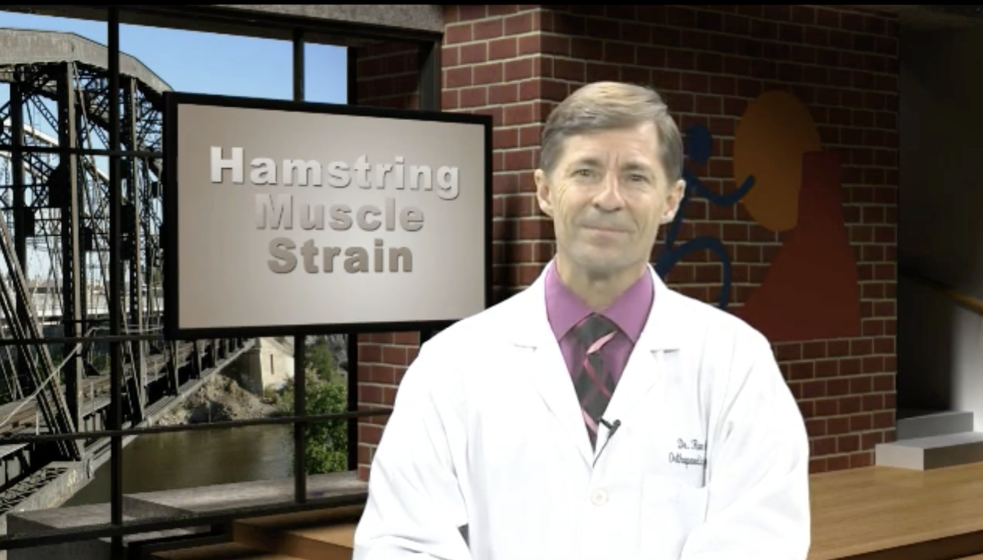Hamstring Muscle Strains
August 4, 2022
Hello and welcome to Yuma Health and Happenings. I’m Dr. Ron Clark, Orthopedic Surgeon and founder of The Bone and Joint Center of Yuma. Today I want to talk about a painful condition that occurs along the back portion of the thigh and makes walking and running difficult. This condition is known as a hamstring muscle injury. This injury generally occurs in sports where intense sprinting is required, such as football, basketball, soccer, and track.
The Role of the Hamstring
The hip joint is formed by the connection between the thigh bone, also called the femur, and the pelvic bone. The hamstring muscles include three different muscles that connect the pelvic bone to the shin bone on the back side of our thighs. The biceps femoris is the largest and attaches to the outside of the shin bone, while there are two muscles on the inner side of the shin bone named the semitendinosus and the semimembranosus. The action of these muscles is to extend the hip backward and bend the knee.
Diagnosing Hamstring Muscle Strains
Injuries to the hamstring muscles can be mild, moderate, and severe. In mild injuries, only a few of the muscle fibers are damaged. The pain and swelling of the injury will be limited and the recovery reasonably straightforward. In moderate injuries, there are more damaged muscle cells. In a severe muscle injury, the muscle may be torn into two sections or pulled entirely off the pelvic bone. When the muscle is torn off the pelvic bone, a small piece of bone may be attached to the muscle, which is visible on x-rays.
There are several risk factors for hamstring injuries that include: muscle tightness which can be improved by stretching before workouts, muscle imbalance because the muscles on the front of the thigh are most often stronger leading to fatigue and injury of the hamstring muscles, poor conditioning or working out beyond your skill level, muscle fatigue by working longer than you should, and choice of sport as those activities that involve sprinting are known to have much more hamstring injuries as others. Dancers can also injure their hamstring muscles, as can adolescents.
Hamstring Muscle Strain Symptoms
Hamstring strains occur more often in adolescents because bones and muscles do not grow at the same rate. A child’s bones may grow faster during a growth spurt than the muscles. The growing bone pulls the muscle tight. A sudden jump, stretch, or impact can tear the muscle away from its connection to the bone.
A hamstring injury’s symptoms include sudden pain in the back of the thigh while running that will cause the athlete to stop and sometimes fall. There will be pain, swelling, and ultimately bruising to the back of the thigh. X-rays may be obtained to evaluate the appearance of the attachment near the hip joint, as the muscle may have torn off a small portion of bone. MRI imaging may help a doctor see how much muscle is involved and determine if surgery is necessary.
Treatments for Hamstring Strains
Treatment involves using cold to limit swelling, crutches in severe cases, and surgery may be recommended if there is a significant muscle separation. RICE–meaning rest, ice, compression, and elevation are all used to care for a hamstring injury immediately. Sometimes a brace may be prescribed to protect the knee joint from moving. Physical therapy can be helpful in using supervised stretching and strengthening to improve care. Anti-inflammatory medications such as ibuprofen and naproxen may relieve some of the pain associated with a muscle injury.
Rehabilitation and return to sports are difficult to predict as healing potential and pain tolerance vary from individual to individual. A mild injury may recover in a couple of weeks, a moderate injury in over a month or two, and a severe injury may need up to 6 months for recovery. In those rare cases where surgery is necessary, at least 6 months to a year may be required before full sports participation will be possible and performance returns to normal.
It is crucial that, before returning to full athletic participation, swelling and pain have resolved. This type of injury can be repeated, especially if the recovery has been inadequate. There is sometimes tremendous pressure in youth sports to have someone return to participation early for an important competition or the need for a talented athlete’s ability. Parents should resist this pressure on behalf of their children, as there can be lifelong consequences for participation too early. For this reason, medical supervision is recommended to reduce the possibility of developing permanent muscle weakness. Proper care and recovery can limit the likelihood of any long-lasting effects.